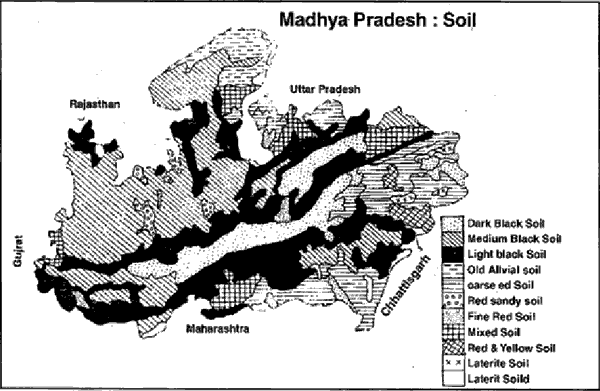(HOT) UPSC Current Affairs 2025 PDF
NEW! The Gist (NOV-2025) | E-BOOKS
(Online Course) Madhya Pradesh PSC: General Studies: Soils
Online Course for Madhya Pradesh Public Service Commission
General Studies: Soils
The agriculture of any state depends upon the type of Soils it has. Soils are formed due to the breakage of rocks. The top most layer of the Soils consists of rocks and living organisms. It is the combination of many chemical complexes.
Not much research has been done on the type of soils found in Madhya Pradesh, but on the basis of minerals and are found in Madhya Pradesh, colour, density, Water retention capacity, porosity etc. the soils is divided into following types:
1) BLACK SOIL
It is also knows as Regur (Humus) soil. Black soil are composed of Basaltic rocks mainly found in the Deccan Trap (Malwa Plateau). It is distributed is nearly 47.6 percent of the land of Madhya Pradesh. Such soils mainly consists of Iron and lime rocks. The presence of Iron gives it the Black colour and the presence of lime increases its moisture retention capacity therefore needs less irrigation. Cotton and soya bean are most suitable crops to be grown in such soil. The quantity of Calcium, Magnesium, Aluminum, Iron, Potassium and Magnesium Carbonate is more in black soil but it laks in Nitrogen, Phosphorous and Carbonic elements. Soil ero sion is lesser in Black soil, Black soil are reclassified in following sub type :
Area of Black Soil- Bhopal, Betul, Barwani, Chhindwara, Damoh, Dhar, Dewas, Vidisha, Shajapur, Jabalpur, Khandwa, Raigarh, Mandsaur, Narsingpur, Raisen, Sidhi, Shivpuri, Seoni, Sehore, Sagar, Guna, Indore, Ujjain, Ratlam, Jhabua.
- Normal Black Soil : This soil founded in northern Malwa plateau and Nimar regions of Madhya Pradesh. It is the moist extensively found black soil and its fertility level is medium.
- Layered Black Soil: It is a clay type smooth black soils found in Chhindwara, Seoni, Betul area. The fertility level of such soil is also medium.

(iii) Dark Black Soil: found in Narmada Valley, Satpura ranges and Southern Malwa Plateau fertility status of these soils is very low.
2) RED YELLOW SOILS
It is mostly found in Bundelkhand and Baghelkhand regions of the state. Its yellow colour is due to the presence of ferric oxide and iis red colour is due to the presence of compounds produced after the oxidation of Iron. Its fertility level's low because it is poor in Nitrogen and Humus. Rice is mostly grown in such soils. This soils covers almost 36.5 percent of the state. Rice is grown is most part of the state on these soils. The pH level of these soils is between 5.5 to 8.5.
Areas of red-yellow soils - Mandla, Balaghat, Shahdol, Sidhi, Katni, Umaria.
3) ALLUVIAL SOILS
This soil mostly found in the North -Western Districts of Madhya Pradesh. Especially in the plains of Bundelkhand and Chambal region or deposition of soils brought by the rivers. It is the most fertile soils. In Madhya Pradesh this soils is found in Gwalior, Shivpuri and Bhind and Morena, brought by the river Chambal and its auxiliary rivers. Such soils are poor in Nitrogen and Phosphorous hence need proper use of fertilizers. Water retention capacity of such soils is also very poor.
4) LATERITE SOILS
This type of soils is found in the North Western part of the state like Shivpuri, Gwalior, Bhind and Morena. The amount of Nitrogen, Organic matter and Phosphorous is less. So vegetation is less in such soils.This soil is suitable for crops like Wheat, Sugarcane, Cotton etc.The proportion of sand, slit and clay.
5) LOAMY SOILS
Such soils are light is texture and mostly found in the plains and river belts. Fertility level is medium and contains sand and clay is almost equal proportion.
6) MIXED SOILS
A mixture of red, yellow and black soils is found in many parts of the state.
This type of soils has very less amount of nitrogen, phosphorous and carbonic
elements. So the soils is not fertile. As the soils is not fertile wheat and
other crops cannot be grown, so crops, which need lesser quantum of nitrogen,
phosphorous and carbonic elements, are grown as such soils such as corn, Bajra
etc.
Areas of mixed soils: Sheopur, Morena, Bhind, Gwalior, Shivpuri.
SOIL EROSION
Soils erosion is the phenomenon of continuous deterioration in the soil due to the shifting of soil through various environmental forces, one of the main factors of soil erosion is Deforestation. Roots of the plants and trees hold the soils in its place and they also sustain the adverse effects of atmospheric forces and therefore prevent soils erosion. But due to extensive deforestation soil erosion is becoming a grave danger to the human civilization, especially in the areas where soils are of light and medium texture. The scene is no different in Madhya Pradesh, which is facing rapid soils erosion in its northern part along the Chambal and its tributaries. Large scale gully erosion can be seen in the belt around the districts of Gwalior, Morena and Bhind. Since the soils of this area are light and lack vegetation thus water takes away soils with its flow and results is erosion. Soils erosion not only disturbs to pographic and ecological balance but large part of fertile sub surface land also goes waste through Run off.Thus it is social, environment and economical problem of the present era. The only way to center this menace is to create a healthy nature friendly ecological environment around us.
